
Vietnamese Fish Sauce: The Ultimate Guide to Its Rich Flavor and Uses
What is nuoc mam?
How to make fish sauce
Why is nuoc mam unique?
How to use fish sauce
Best regions for fish sauce
Top Vietnamese fish sauce brands
Vietnamese vs. Thai fish sauce
Vegan fish sauce
Where to buy authentic fish sauce
Price
FAQs
What is nuoc mam? Understanding Vietnamese fish sauce
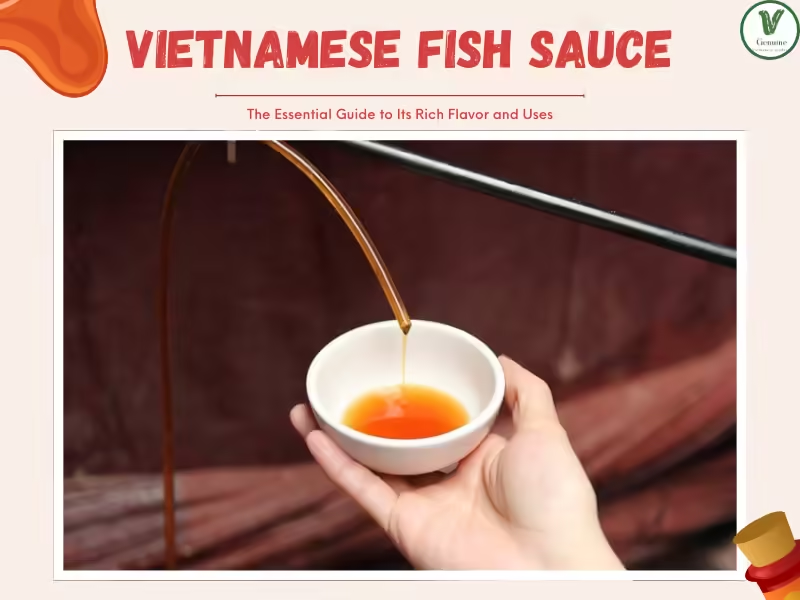
Nuoc mam, or Vietnamese fish sauce, is a traditional Vietnamese condiment made by fermenting fish with salt. Known for its bold, savory flavor, it is a key ingredient in Vietnamese cuisine and is often paired with various Vietnamese spices to enhance its richness. Internationally, it is commonly referred to as “Vietnamese fish sauce,” but nuoc mam is the authentic Vietnamese term. Both names refer to the same unique and flavorful ingredient.
How to make Vietnamese fish sauce
Vietnamese fish sauce is crafted through a traditional process that creates its unique, savory flavor. Here’s how it’s done:
Selecting the Ingredients: Fresh anchovies and high-quality sea salt are key.
Mixing: Anchovies are combined with salt in a 3:1 ratio and stored in wooden barrels.
Fermentation: The mixture is left to ferment for 12 months, allowing the flavors to develop.
Extraction: After a year, the dark amber fish sauce is extracted, rich in aroma and flavor.
To better understand the traditional process, here’s a quick visual guide to how Vietnamese fish sauce is made
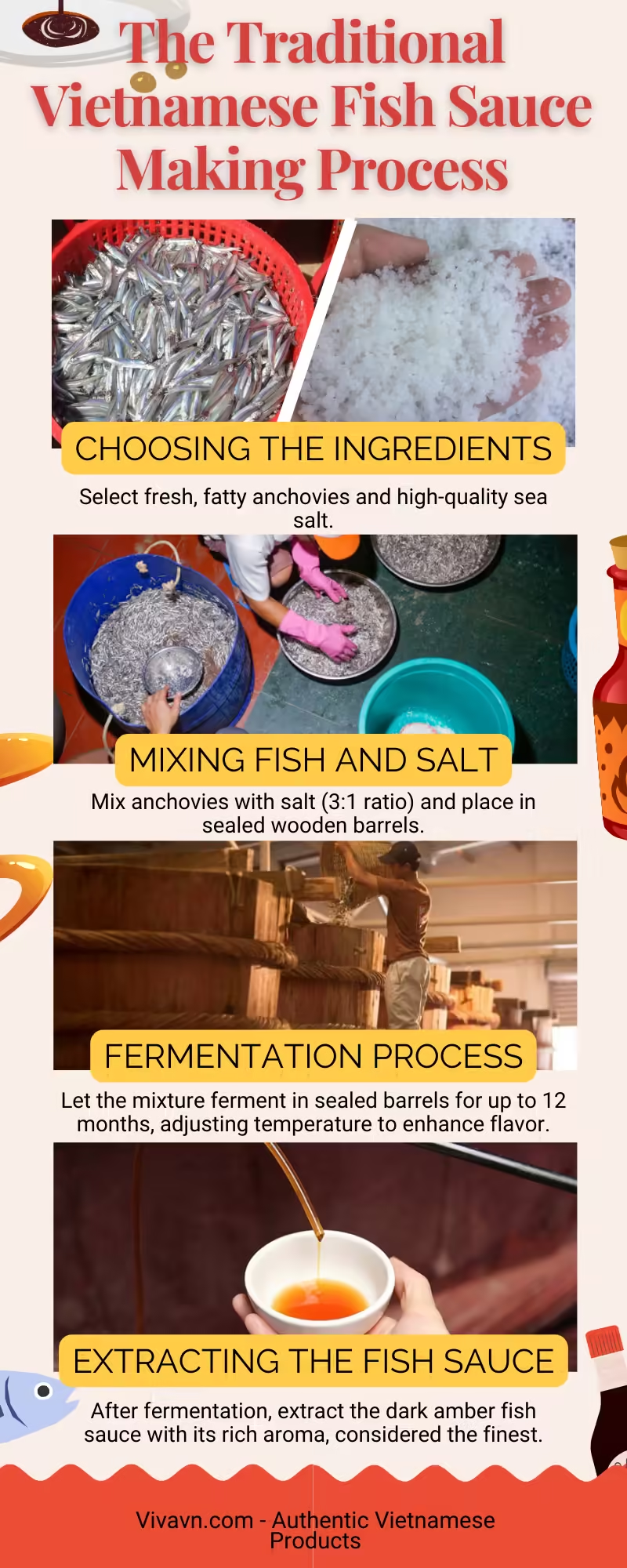
In addition to anchovies, mackerel, and scad fish are also commonly used to make fish sauce in Vietnam, each contributing their own unique flavor profile to the final product.
What makes Vietnamese fish sauce unique?
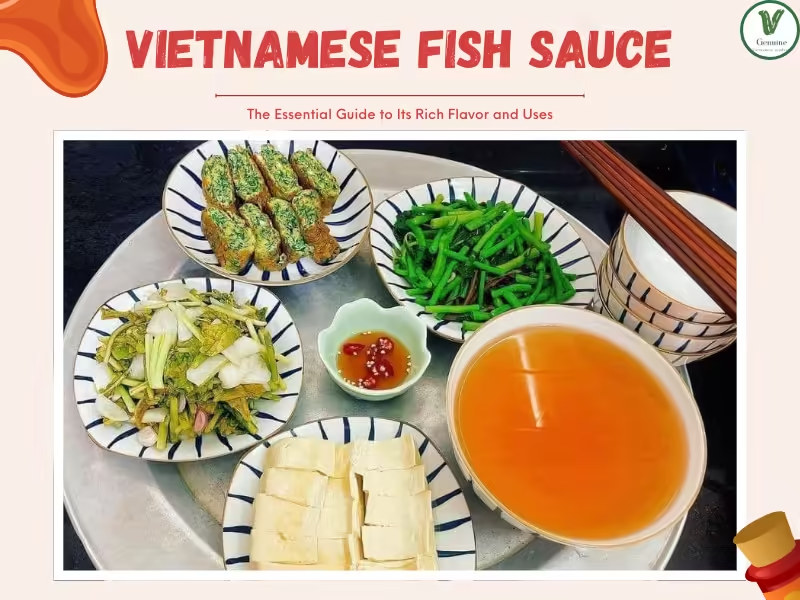
Vietnamese fish sauce, or nuoc mam, is an essential ingredient in Vietnamese cuisine. From iconic dishes like pho (Vietnamese noodle soup), bun bo (Vietnamese spicy beef noodle soup), and nem ran (fried spring rolls), to banh xeo (Vietnamese sizzling pancakes), it’s hard to imagine Vietnamese food without it. Let’s dive in and discover what makes nuoc mam so special.
1. High-quality ingredients
The foundation of Vietnamese fish sauce lies in its ingredients. The primary fish used is anchovy, caught at the peak of its season to ensure it is fatty and flavorful, then combined with pure sea salt.
2. Long fermentation process
Unlike many fish sauces that ferment for only a few months, Vietnamese fish sauce undergoes a long fermentation process. Anchovies and salt are left to ferment in wooden barrels for at least 12 months, allowing the proteins to break down and develop a rich, complex flavor prized in Vietnamese cuisine.
3. Rich and complex flavor profile
Vietnamese fish sauce has a unique aroma that no other fish sauce in the world can replicate. It’s known for its deep umami flavor, perfectly balanced between salty, sweet, and savory notes. This distinct taste comes from centuries of expertise passed down through generations of Vietnamese fish sauce makers.
4. Cultural significance
In Vietnamese culture, fish sauce (nuoc mam) is more than just a seasoning—it represents connection. A bowl of fish sauce is placed at the center of the family table during meals, symbolizing community, love, and togetherness.
How to use Vietnamese fish sauce in cooking
In Vietnamese cuisine, fish sauce (nuoc mam) is a key ingredient used in a variety of ways, enhancing the flavor profile of many dishes. Here are the most common uses:
Nuoc cham (Vietnamese dipping sauce): A flavorful mixture made from fish sauce, sugar, lime juice, garlic, chili, and water.
Seasoning for cooking: Fish sauce, along with other spices, is used to marinate ingredients before cooking.
Preserving foods: During the Vietnamese Lunar New Year), people often pickle ingredients like onions, and carrots in fish sauce to enjoy for several days. See more in our article on Vietnamese Tet food.
What is nuoc cham? (Vietnamese dipping sauce)
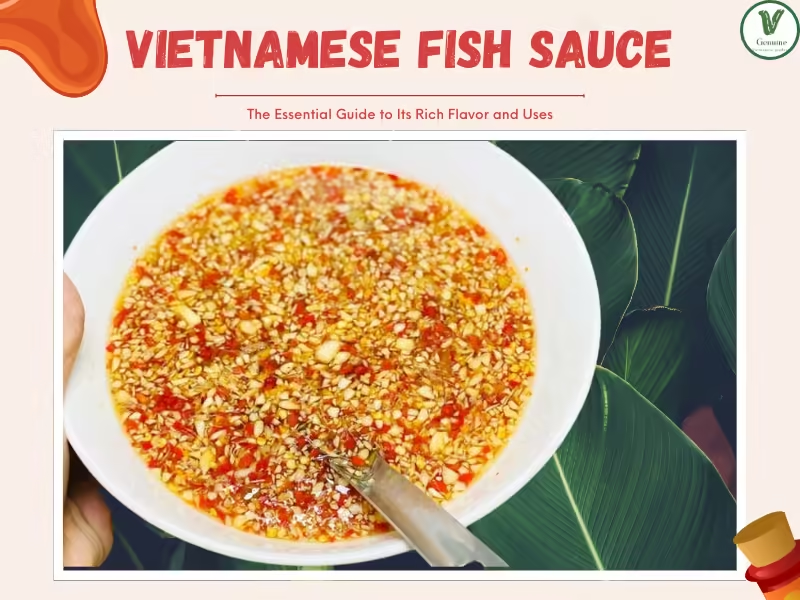
Nuoc cham is a classic Vietnamese dipping sauce that perfectly blends sweet, sour, salty, and spicy flavors. It’s the sauce that ties so many iconic dishes together – think goi cuon (fresh spring rolls), banh xeo (Vietnamese pancake), nem ran (Vietnamese fried spring rolls), … Its base is typically made from fish sauce (nuoc mam) mixed with other ingredients such as:
Sugar: Adds a hint of sweetness.
Lime juice or vinegar: Provides a tangy balance.
Garlic and chili: Introduces heat and aroma.
Water: Helps dilute and balance the flavors.
How to make nuoc cham – Vietnamese dipping sauce
Here’s an easy step-by-step authentic Vietnamese nuoc cham recipe:
Ingredients:
1 tablespoon high-quality fish sauce
1 tablespoon fresh lime juice
1 tablespoon sugar
4 tablespoons water
Finely chopped garlic and chili
Instructions:
Dissolve the sugar: Combine 4 tablespoons of water with 1 tablespoon of sugar in a bowl. Stir until the sugar is fully dissolved. If the water is warm, the sugar will dissolve much faster.
Add fish sauce and lime juice: Mix in 1 tablespoon of fish sauce and 1 tablespoon of fresh lime juice. Stir well to combine.
Incorporate garlic and chili: Add finely chopped garlic and chili to the mixture. Stir until evenly distributed.
Let it rest: For the best flavor, let the sauce sit for at least 15 minutes.
Note: You can adjust the amount of fish sauce according to your taste. The sauce should be a little strong, as it will be paired with unseasoned food.
Popular dishes that use nuoc cham dipping sauce
Nuoc cham is a versatile dipping sauce that pairs perfectly with a variety of Vietnamese dishes. Here are some popular dishes that traditionally use this flavorful sauce:
Vietnamese fresh spring rolls (goi cuon)
Fresh spring rolls, or “goi cuon“, are a classic Vietnamese dish made with fresh, vibrant ingredients like seafood, meat, rice noodles, Vietnamese herbs, and vegetables, all wrapped in soft rice paper. When served, these ingredients are tightly rolled up in the rice paper and enjoyed with a flavorful dipping sauce.
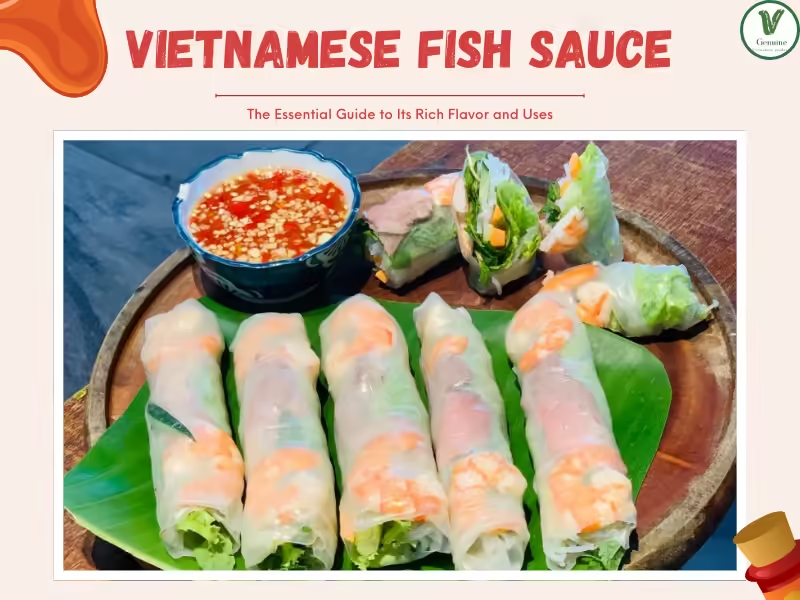
Vietnamese fried spring rolls (cha gio)
Vietnamese fried spring rolls, known as cha gio, are made with a delicious filling of ground pork, glass noodles, eggs, and wood ear mushrooms, seasoned with classic Vietnamese flavors like scallions, black pepper, and fish sauce. The mixture is wrapped in rice paper and deep-fried until golden and crispy. They’re typically served with Vietnamese dipping sauce (nuoc cham), pickled vegetables, and a variety of fresh herbs.
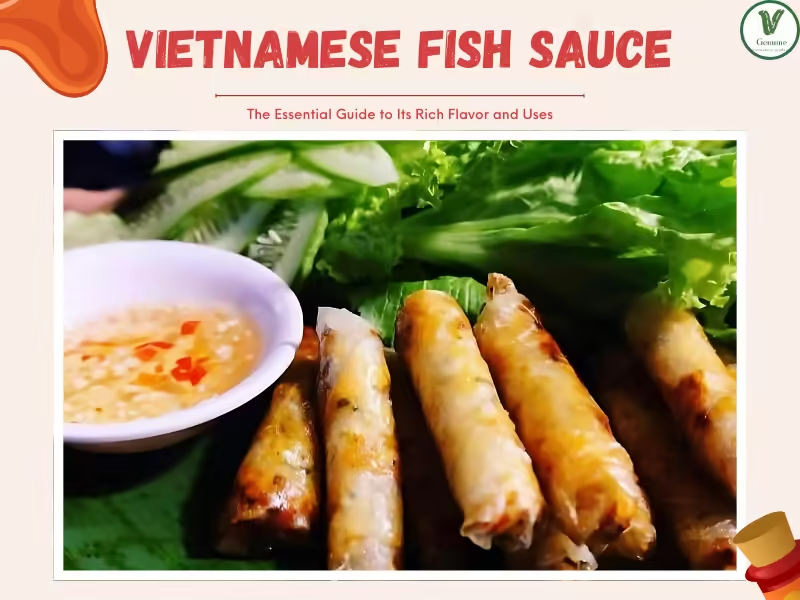
Vietnamese vermicelli with grilled pork (bun thit nuong)
Vietnamese vermicelli with grilled pork, or bun thit nuong, is a refreshing and flavorful dish loved across Vietnam. It features cold rice vermicelli noodles as the base, topped with grilled pork, fresh herbs like basil and mint, lettuce, and crunchy bean sprouts. The dish is served with a tangy, sweet, and savory nuoc cham (Vietnamese dipping sauce) and finished with roasted peanuts, and pickled carrots.
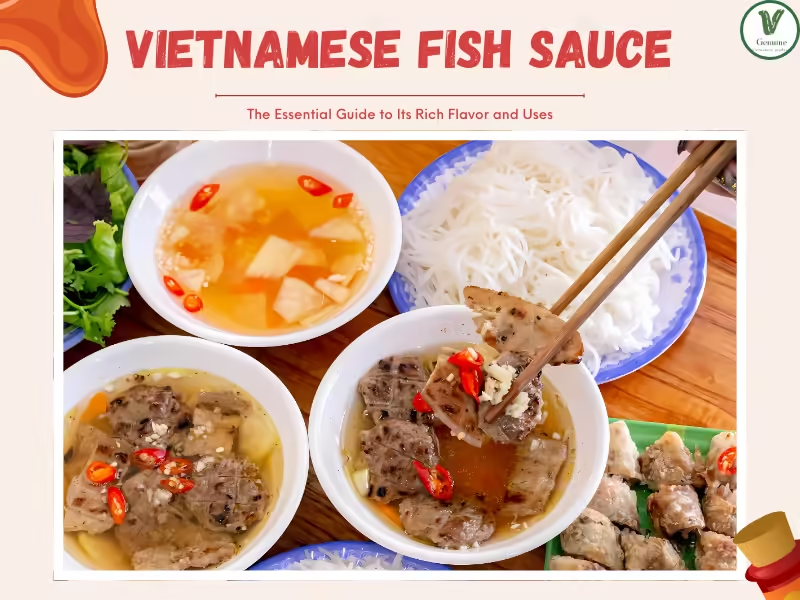
Vietnamese sizzling pancakes (banh xeo)
Banh xeo has a nice crunch and a bit of chewiness. It’s made from a crispy rice flour pancake filled with tasty shrimp, pork, and bean sprouts. You can enjoy it with greens like lettuce, mustard greens, Vietnamese coriander, and basil, all dipped in flavorful Vietnamese nuoc cham.
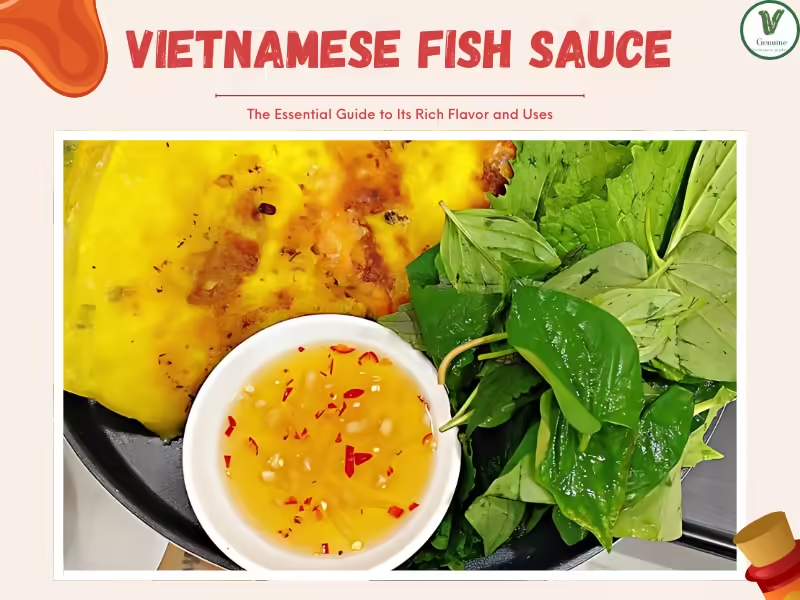
Which regions are known for the best Vietnamese fish sauce?
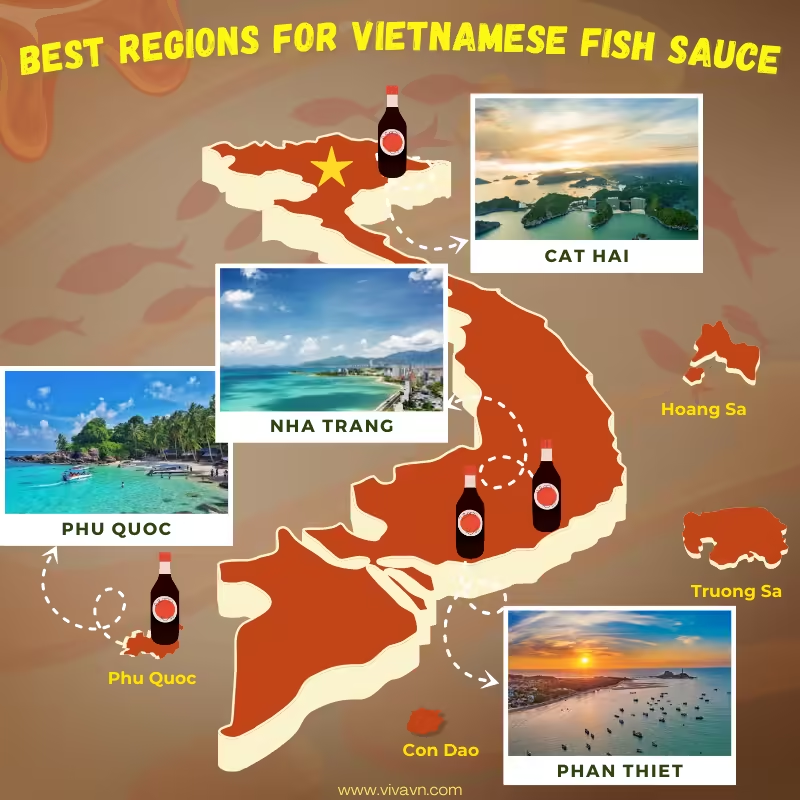
Phu Quoc fish sauce
Phu Quoc fish sauce is a name used to describe the varieties of fish sauce made on Phu Quoc Island, located in the southwestern part of Vietnam. Known for its centuries-old tradition, the island produces premium fish sauce using anchovies from the surrounding waters.
The best anchovies are harvested between July and December, salted immediately on the boat, and then fermented for over 12 months in wooden barrels. The traditional fermentation process and techniques passed down through generations give Phu Quoc fish sauce its rich, distinctive flavor, making it one of Vietnam’s most popular varieties.
Phu Quoc fish sauce carries a prestigious geographical indication, signifying its unique qualities tied to the island’s traditional production methods. Here’s what sets it apart:
Rich Color: It features a reddish cast, ranging from amber to deep caramel
Aromatic: Phu Quoc fish sauce is known for its mild, distinct aroma, free from fishy or ammonia-like smells.
Balanced Flavor: The taste is a perfect balance of salty and naturally sweet, with a subtle richness from anchovy oils. It leaves a slightly sweet, smooth aftertaste.
Protein Content: With nitrogen levels (a measure of natural protein) between 20°N and 43°N.
Phan Thiet fish sauce
Phan Thiet fish sauce refers to varieties made in Phan Thiet, a coastal city in southern Vietnam. The tradition of making fish sauce here dates back to the 1800s, and the region is well-known for its high-quality fish sauce.
Nha Trang fish sauce
Nha Trang fish sauce refers to the varieties produced in the beautiful coastal city of Nha Trang in central Vietnam. With its favorable climate, abundant fish supply, and centuries-old traditional fish sauce-making techniques, Nha Trang fish sauce is highly popular throughout Vietnam.
Cat Hai fish sauce
Cat Hai is an island located in Hai Phong City, in the northern part of Vietnam. Compared to fish sauce from other regions, Cat Hai fish sauce has a light aroma and tends to be saltier. It’s particularly well-suited for preparing dishes with the distinct flavors of northern Vietnamese cuisine.
What are the best Vietnamese fish sauce brands?
Red Boat fish sauce (Phu Quoc)
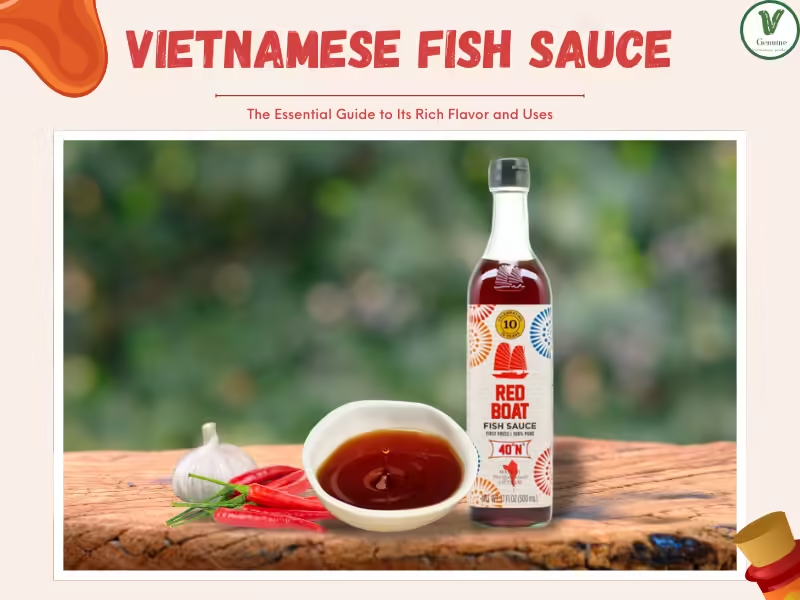
Known for its premium quality, Red Boat is a globally recognized brand that produces high-quality Phu Quoc fish sauce. This brand uses traditional fermentation methods, resulting in a rich, umami-packed flavor that’s perfect for cooking and dipping.
Khai Hoan fish sauce (Phu Quoc)
Khải Hoàn is one of the largest traditional fish sauce producers on Phu Quoc Island, with over 40 years of experience crafting this iconic Vietnamese condiment. They even offer guided tours where visitors can see firsthand how their authentic fish sauce is made.
Tin fish sauce (Phant Thiet)
Tin Fish Sauce has been handcrafted in Phan Thiet for over 300 years, carrying on a rich tradition of Vietnamese cuisine. While their fish sauce is typically aged for 12 months, they also offer a premium version aged up to 36 months, creating an exceptionally bold and unique flavor.
Vietnamese vs Thai fish sauce: What’s the difference?
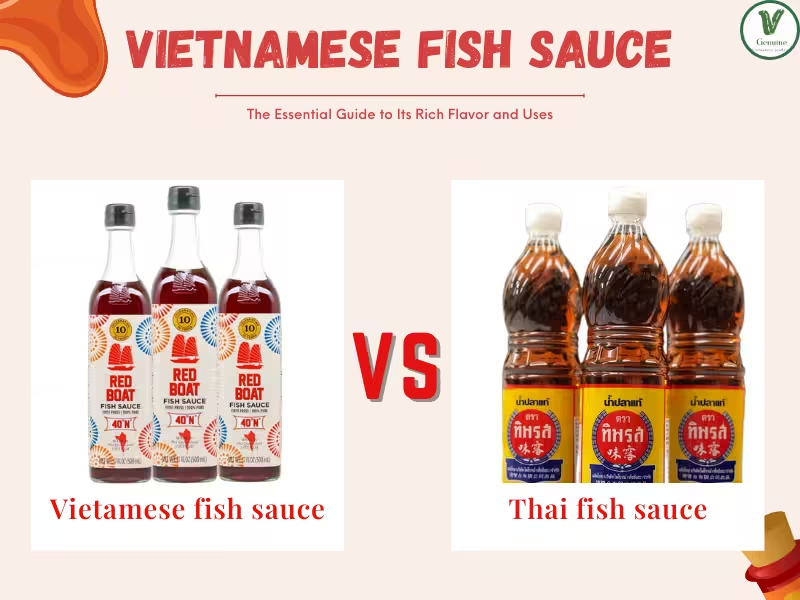
Vietnamese and Thai fish sauces share a lot in common, including their key ingredients—anchovies, salt, and water—and a fermentation process that typically lasts from 12 months or more. However, the two differ significantly in taste.
Vietnamese fish sauce tends to have a lighter, slightly sweeter flavor, while Thai fish sauce leans saltier and bolder in profile. The difference in taste between Vietnamese and Thai fish sauces can also be attributed to the distinct fermentation techniques used in each country.
Name
Ingredients
Fermentation Time
Flavor Profile
Vietnamese fish sauce
Nuoc mam
Anchovies, salt, and water.
12 months or more
Lighter, slightly sweeter.
Thai fish sauce
Nam pla
Anchovies, salt, and water.
12 months or more
Saltier, with a deeper kick.
To get the most authentic flavors, it’s always a good idea to use the right fish sauce for each cuisine. Vietnamese fish sauce works wonders for Vietnamese dishes, while Thai fish sauce is perfect for bringing out the bold flavors in Thai cooking.
What is Vietnamese vegan fish sauce (vegetarian nuoc cham)?
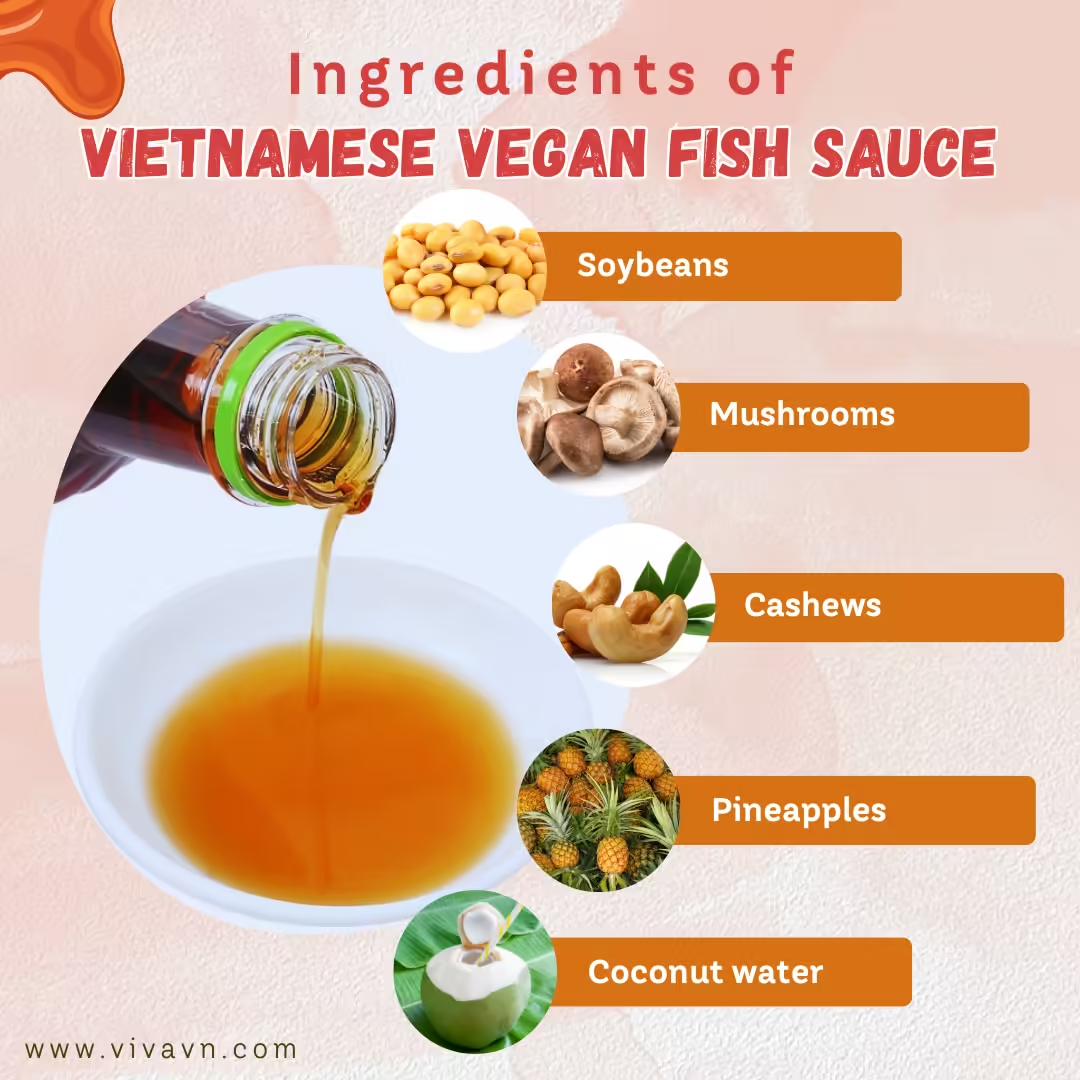
Vietnamese vegan fish sauce, or vegetarian nuoc cham, is a plant-based version of traditional fish sauce made from ingredients like soybeans, pineapples, mushrooms, cashews, and coconut water. Through careful fermentation, it captures the rich umami flavor found in regular fish sauce, providing a delicious and cruelty-free alternative perfect for vegan and vegetarian diets.
Where to buy authentic Vietnamese fish sauce?
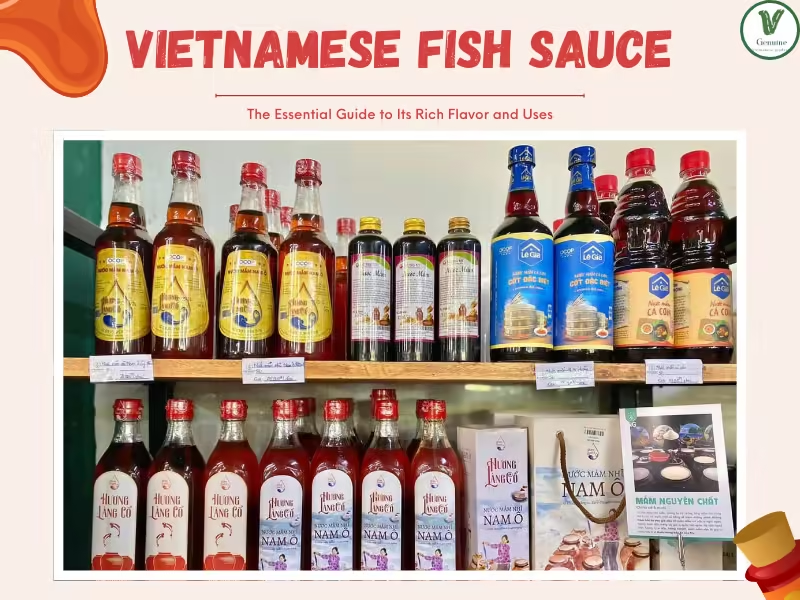
To buy authentic Vietnamese fish sauce, you can start by checking specialty Asian markets, particularly Vietnamese stores, which are more likely to carry high-quality brands. One of the most popular and highly recommended premium brands is Red Boat. Known for its traditional fermentation process and rich flavor, Red Boat is a favorite among those looking for authentic fish sauce.
You can also explore online marketplaces such as Amazon or specialty sites that offer international shipping, where premium options like Red Boat are readily available.
Vietnamese nuoc mam price
When it comes to the price of Vietnamese fish sauce, it can vary depending on the brand, quality, and where you buy it. Generally, premium Vietnamese fish sauce made from high-quality ingredients, like the ones from Phu Quoc Island, can cost between $10 to $15 for a 500ml bottle.
FAQs: Top questions about Vietnamese nuoc mam answered
How to make nuoc mam (Vietnamese fish sauce)?
Nuoc mam, or Vietnamese fish sauce, is made by fermenting anchovies and salt using a traditional process. Here’s a step-by-step breakdown:
- Selecting the Ingredients: Fresh anchovies and high-quality sea salt are essential for the best flavor.
- Mixing: The anchovies are mixed with sea salt in a 3:1 ratio and stored in wooden barrels.
- Fermentation: The mixture ferments for 12 months, allowing the flavors to develop.
- Extraction: After a year, the fish sauce is extracted, resulting in a rich, dark amber liquid full of flavor.
For a visual breakdown, check out our full section on How to make Vietnamese fish sauce, along with our informative infographic.
What do the ’40°N’, ’30°N’, ’20°N’, or ’10°N’ labels on Vietnamese fish sauce mean?
The numbers you see on Vietnamese fish sauce bottles, such as 40°N, 30°N, 20°N, or 10°N, refer to the nitrogen content in the sauce. This measure helps indicate the quality and richness of the fish sauce. In Vietnam, fish sauce is graded according to its nitrogen content (°N), which reflects its intensity of flavor and overall quality. The higher the nitrogen content, the richer and more flavorful the fish sauce is considered to be:
- Special grade: Over 30°N
- Premium grade: Over 25°N
- Grade 1: Over 15°N
- Grade 2: Over 10°N
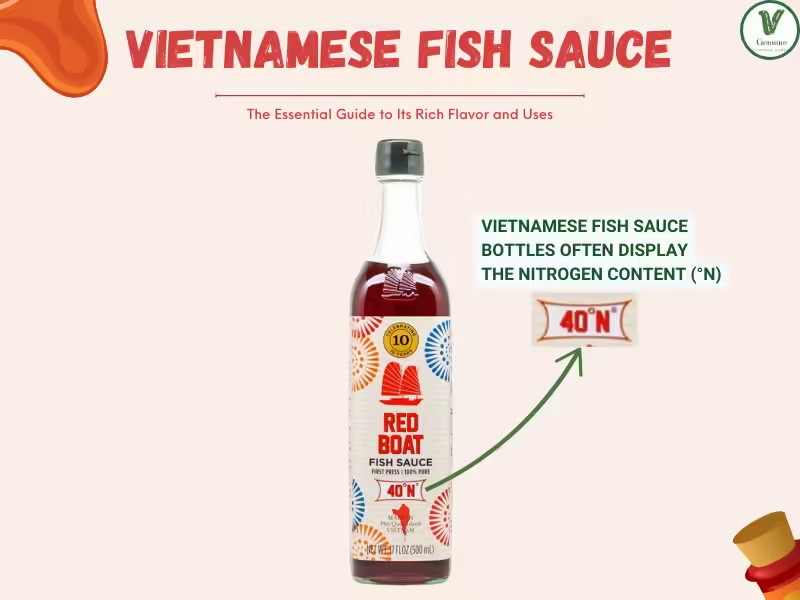
Why is fish sauce so popular in Vietnam?
Fish sauce is not just a regular seasoning in Vietnam—it’s a key part of the country’s food culture. Here’s why it’s so popular:
- Abundant fresh fish: Vietnam’s long coastline provides a steady supply of fresh fish, the main ingredient for fish sauce.
- Culinary heritage: Fish sauce has been an essential part of Vietnamese cooking for centuries. It’s deeply tied to the country’s food traditions and is used in everyday meals.
- Flavor enhancer: The condiment is essential for enhancing and balancing flavors in Vietnamese dishes, acting as a bridge between ingredients. Iconic dishes like banh xeo (Vietnamese sizzling pancakes), goi cuon (fresh spring rolls), pho (Vietnamese noodle soup), and bun bo (Vietnamese spicy beef noodle soup) heavily rely on fish sauce to achieve their distinct and traditional tastes.
What is nuoc cham made of?
Nuoc cham is a popular Vietnamese dipping sauce made primarily from fish sauce (nuoc mam) and combined with other ingredients to balance its flavors. Here’s what typically goes into it:
- Sugar: Adds a touch of sweetness.
- Lime juice or vinegar: Provides a tangy balance to the sauce.
- Garlic and chili: Brings heat and aromatic flavors.
- Water: Dilute the sauce to achieve the perfect balance of taste.
Share on FacebookShare on X (Twitter)Share on PinterestShare on WhatsappShare on LinkedinShare on TelegramShare on Email
- https://www.youtube.com/@VivaVNOfficial
- https://www.facebook.com/vivavnofficial2024
- https://www.pinterest.com/vivavnofficial/
© 2025 VivaVN. All rights reserved.


Leave a Reply